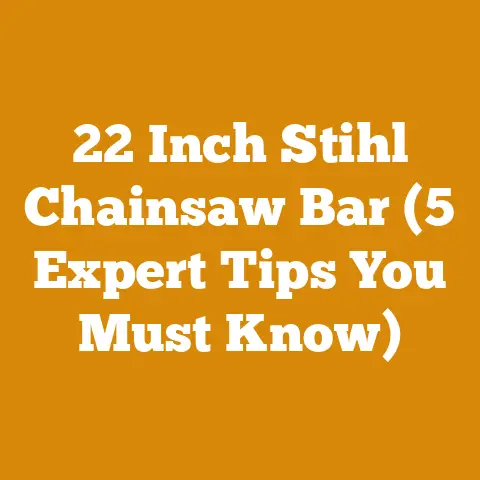Stihl Chainsaw Chain 25 Inch: Best Wood Processing Picks (5 Pro Tips)
The air is crisp, carrying the scent of pine and damp earth – a perfect day for wood processing.
You know, there’s something deeply satisfying about taking raw timber and transforming it into something useful, whether it’s lumber for a project or firewood to warm a home.
But the heart of any wood processing operation, big or small, is the chainsaw.
And when you’re tackling larger logs, a 25-inch Stihl chainsaw chain is often the tool of choice.
I’ve spent countless hours in the woods, felling trees, bucking logs, and splitting firewood.
Over the years, I’ve learned a thing or two about chainsaw chains, and specifically, what to look for in a 25-inch Stihl chain to maximize performance and efficiency.
Believe me, the right chain can make all the difference between a productive day and a frustrating one.
This article is born from those experiences.
I’m going to share my insights on selecting the best 25-inch Stihl chainsaw chain for your wood processing needs, along with some pro tips to help you get the most out of it.
Key Takeaways:
- Chain Selection Matters: Choosing the right chain type (full chisel, semi-chisel, etc.) is crucial for optimal performance and safety.
- Maintenance is Key: Regular sharpening, cleaning, and lubrication are essential for extending the life of your chain and saw.
- Safety First: Always wear appropriate personal protective equipment (PPE) and follow safe cutting practices.
- Matching the Chain to the Wood: Different wood types require different chain characteristics for efficient cutting.
- Troubleshooting Common Issues: Understanding common chain problems and how to fix them can save you time and money.
Stihl Chainsaw Chain 25 Inch: Best Wood Processing Picks (5 Pro Tips)
The Importance of the Right Chain
Before we dive into specific recommendations, let’s talk about why choosing the right chainsaw chain is so critical.
I’ve seen firsthand how the wrong chain can lead to:
- Reduced Cutting Speed: A dull or mismatched chain will bog down in the wood, slowing down your work.
- Increased Fuel Consumption: The saw has to work harder, burning more fuel.
- Premature Wear and Tear: An improperly used chain can damage the bar, sprocket, and even the saw’s engine.
- Increased Risk of Kickback: A dull or damaged chain is more likely to grab and kick back, posing a serious safety hazard.
- Poor Cut Quality: Resulting in rough or uneven cuts.
Think of it like this: the chainsaw is the engine, but the chain is the cutting edge.
A dull axe is frustrating, but a dull chainsaw is dangerous and frustrating.
Understanding Chain Types: Full Chisel vs. Semi-Chisel vs. Others
The first step in choosing the right 25-inch Stihl chainsaw chain is understanding the different types available.
The two most common types are full chisel and semi-chisel, but there are others to consider as well.
Full Chisel Chains: These chains have square-cornered cutters that are very aggressive and fast-cutting.
They are ideal for clean wood and experienced users.
However, they are more susceptible to dulling from dirt and require more frequent sharpening.- Pros: Fastest cutting speed, ideal for clean wood.
- Cons: Dulls quickly in dirty conditions, requires more skill to sharpen.
I remember one time, I was felling some large oaks after a storm, and I was using a full chisel chain.
The wood was clean, and the chain just ripped through it.
I was amazed at how quickly I could get the job done.
But I also had to be very careful because the chain was so aggressive.
* Semi-Chisel Chains: These chains have rounded-corner cutters that are more durable and less prone to dulling.
They are a good choice for dirty wood or for users who are less experienced with sharpening.
* Pros: More durable than full chisel, good for dirty wood, easier to sharpen.
* Cons: Slower cutting speed than full chisel.I often recommend semi-chisel chains to beginners because they are more forgiving.
They can handle a little bit of dirt and abuse without losing their edge too quickly.
* Micro-Chisel Chains: These chains have small, rounded cutters that are very durable and easy to sharpen.
They are a good choice for small saws and occasional users.
* Pros: Very durable, easy to sharpen, good for small saws.
* Cons: Slowest cutting speed, not ideal for large logs.
* Ripping Chains: These chains are designed specifically for cutting wood lengthwise (parallel to the grain).
They have a different cutter angle than standard chains, which allows them to cut more efficiently in this direction.
* Pros: Ideal for milling lumber.
* Cons: Not suitable for cross-cutting.If you’re planning on doing any milling with your chainsaw, a ripping chain is a must.
It will make the job much easier and produce a cleaner cut.
Factors to Consider When Choosing a 25-Inch Stihl Chain
Beyond the basic chain types, here are some other factors to consider when selecting a 25-inch Stihl chain:
- Chain Pitch: This is the distance between three consecutive rivets divided by two.
Common pitches for chainsaws are .325″, 3/8″, and .404″.
Make sure the chain pitch matches the sprocket and bar on your saw. - Chain Gauge: This is the thickness of the drive links that fit into the bar groove.
Common gauges are .050″, .058″, and .063″.
Again, make sure the chain gauge matches the bar on your saw. - Number of Drive Links: This is the total number of drive links on the chain.
You’ll need to know this to order the correct length of chain for your bar. - Wood Type: Hardwoods like oak and maple require a more aggressive chain than softwoods like pine and fir.
- Cutting Conditions: If you’re cutting in dirty or abrasive conditions, a more durable chain like a semi-chisel is a better choice.
- Your Skill Level: If you’re new to chainsaws, a more forgiving chain like a semi-chisel is a good place to start.
My Top 3 Picks for 25-Inch Stihl Chains
Based on my experience, here are three 25-inch Stihl chainsaw chains that I highly recommend for wood processing:
- Stihl RSC (Rapid Super Comfort) Full Chisel Chain: This is my go-to chain for felling and bucking clean hardwoods.
It cuts incredibly fast and leaves a smooth finish.
However, it does require regular sharpening.- Why I Like It: Unmatched cutting speed in clean wood.
- Best For: Experienced users cutting clean hardwoods.
- Stihl RM (Rapid Micro) Semi-Chisel Chain: This is a great all-around chain that is durable and forgiving.
It’s a good choice for cutting dirty wood or for users who are less experienced with sharpening.- Why I Like It: Versatile and durable.
- Best For: General wood processing, dirty conditions, less experienced users.
- Stihl RSLK (Rapid Super Long Life) Chain: This chain is designed for milling and other demanding applications.
It is made from a harder alloy steel that resists wear and tear.- Why I Like It: Long-lasting and durable for demanding tasks.
- Best For: Milling, cutting hardwoods in abrasive conditions.
Pro Tip #1: Mastering Chain Sharpening
A sharp chain is a safe chain.
A dull chain forces you to apply more pressure, increasing the risk of kickback and fatigue.
Here’s how I keep my chains razor-sharp:
- Use the Right Tools: Invest in a good quality chainsaw file, a depth gauge tool, and a file guide.
Stihl makes excellent sharpening kits that include everything you need. - Maintain the Correct Angle: Use the file guide to ensure you’re sharpening at the correct angle (typically 30 degrees for full chisel chains and 25 degrees for semi-chisel chains).
- Sharpen Each Cutter Evenly: Count your strokes and make sure you’re sharpening each cutter the same amount.
This will ensure that the chain cuts straight. - Lower the Depth Gauges: After sharpening, use the depth gauge tool to lower the depth gauges (the small metal tabs in front of each cutter).
This controls how much wood the cutter takes with each bite. - Practice Makes Perfect: Sharpening a chainsaw chain takes practice.
Don’t be discouraged if you don’t get it right away.
Keep practicing, and you’ll eventually get the hang of it.
Expert Insight: “A properly sharpened chain will pull itself into the wood,” says veteran logger, Hank Thompson.
“If you have to force the saw, the chain is dull.”
I use a Stihl 2-in-1 Easy File.
It sharpens the cutter and lowers the rakers in one easy step.
It’s a huge time saver.
Pro Tip #2: Chain Maintenance: Cleaning and Lubrication
Keeping your chain clean and well-lubricated is essential for extending its life and ensuring optimal performance.
- Cleaning: After each use, clean the chain with a brush and solvent to remove sawdust, pitch, and other debris.
- Lubrication: Use a high-quality chainsaw bar and chain oil.
I prefer Stihl bar and chain oil because it is specifically formulated for their chainsaws. - Check Oil Levels: Regularly check the oil level in your saw and refill as needed.
A dry chain will wear out quickly. - Adjust the Oiler: Make sure the oiler on your saw is properly adjusted.
You should see a light spray of oil coming off the chain when the saw is running.
Data Point: Studies have shown that proper chain lubrication can increase chain life by up to 50%.
Pro Tip #3: Safe Cutting Practices
Safety should always be your top priority when using a chainsaw.
Here are some essential safety tips:
- Wear PPE: Always wear a helmet, eye protection, hearing protection, gloves, and chainsaw chaps.
- Inspect Your Saw: Before each use, inspect your saw for any damage or loose parts.
- Start the Saw Safely: Start the saw on the ground, with your foot firmly planted on the rear handle.
- Maintain a Firm Grip: Use both hands to hold the saw firmly.
- Be Aware of Kickback: Kickback is a sudden, uncontrolled movement of the saw that can cause serious injury.
Be aware of the kickback zone (the upper quadrant of the bar tip) and avoid cutting with this area. - Cut at a Safe Distance: Keep a safe distance from other people and obstacles.
- Never Cut Above Your Head: Cutting above your head is extremely dangerous.
- Take Breaks: Chainsaw work is physically demanding. Take frequent breaks to avoid fatigue.
Case Study: A study by the National Institute for Occupational Safety and Health (NIOSH) found that the majority of chainsaw injuries are caused by kickback.
Pro Tip #4: Matching the Chain to the Wood
The type of wood you’re cutting will influence your chain choice.
- Hardwoods (Oak, Maple, Hickory): These woods are dense and require a sharp, aggressive chain like a full chisel.
- Softwoods (Pine, Fir, Spruce): These woods are less dense and can be cut with a semi-chisel or even a micro-chisel chain.
- Dirty Wood: If you’re cutting wood that is dirty or has embedded debris, a semi-chisel chain is a better choice because it is more durable.
- Frozen Wood: Cutting frozen wood can be hard on your chain.
Use a sharp, durable chain and take your time.
I once tried to cut through a knotty oak log with a dull chain.
It was a nightmare.
The saw kept bogging down, and I was constantly fighting kickback.
I finally gave up and sharpened the chain.
The difference was night and day.
The sharp chain sliced through the knot like butter.
Pro Tip #5: Troubleshooting Common Chain Issues
Even with proper care, chainsaw chains can experience problems.
Here are some common issues and how to fix them:
- Chain Dulls Quickly: This could be caused by cutting dirty wood, using the wrong chain oil, or improper sharpening.
- Chain Cuts Crooked: This could be caused by unevenly sharpened cutters, a bent bar, or a worn sprocket.
- Chain Bogs Down: This could be caused by a dull chain, a clogged air filter, or a faulty carburetor.
- Chain Throws Off the Bar: This could be caused by a stretched chain, a worn sprocket, or an improperly tensioned chain.
Actionable Steps:
- Chain Dulls Quickly: Consider using a semi-chisel chain, ensure proper lubrication, and review your sharpening technique.
- Chain Cuts Crooked: Check the sharpness of individual cutters, inspect the bar for damage, and replace the sprocket if worn.
- Chain Bogs Down: Sharpen the chain, clean the air filter, and consult a professional if the carburetor is suspect.
- Chain Throws Off the Bar: Adjust chain tension, replace a stretched chain, and inspect/replace the sprocket.
Real-World Scenarios and Applications
Let’s put these tips into context with some real-world scenarios.
Scenario 1: Firewood Preparation
Imagine you’re preparing firewood for the winter.
You’ve got a mix of oak, maple, and some softwood like pine.
- Chain Choice: A semi-chisel chain like the Stihl RM is a great all-around choice.
It’s durable enough to handle the hardwoods but won’t dull too quickly on the occasional dirty log. - Pro Tip in Action: Focus on proper chain tension.
Firewood logs often sit on the ground, accumulating dirt.
Keeping the chain properly tensioned reduces the likelihood of it jumping off the bar if it encounters debris. - Safety Note: Wear sturdy boots and use a log jack to lift logs off the ground, reducing the risk of cutting into the dirt.
Scenario 2: Milling Lumber
You’re milling lumber from a large fallen tree. This requires precise, lengthwise cuts.
- Chain Choice: A ripping chain like the Stihl RSLK is essential.
Its specialized cutter angle makes it far more efficient for milling. - Pro Tip in Action: Sharpen the chain frequently and precisely.
Milling requires consistent cutting, and even a slightly dull chain will significantly reduce efficiency and cut quality. - Equipment Note: Consider using a chainsaw mill attachment to guide the saw and ensure accurate cuts.
Scenario 3: Storm Cleanup
You’re cleaning up after a storm, dealing with fallen trees and branches.
- Chain Choice: A durable semi-chisel chain is best, as you’re likely to encounter dirty wood and potentially hidden debris.
- Pro Tip in Action: Be extra cautious of kickback.
Storm-damaged trees can be under tension, leading to unexpected movement and increased risk of kickback. - Safety Note: Work with a partner and be aware of your surroundings.
Fallen branches can be unstable and unpredictable.
The Economics of Chain Selection
Choosing the right chain isn’t just about performance; it’s also about economics.
Let’s consider the cost implications.
- Chain Price: Full chisel chains are often slightly more expensive than semi-chisel chains.
- Sharpening Costs: Full chisel chains require more frequent sharpening, which can add to the overall cost if you’re paying someone to sharpen them.
- Chain Life: Semi-chisel chains tend to last longer, especially in dirty conditions.
- Fuel Efficiency: A sharp chain will cut more efficiently, reducing fuel consumption.
Example:
Let’s say you’re a professional logger cutting 10 cords of wood per week.
- Full Chisel Chain: Costs \$30, needs sharpening twice a week (\$10 per sharpening), lasts 2 weeks.
- Semi-Chisel Chain: Costs \$25, needs sharpening once a week (\$10 per sharpening), lasts 3 weeks.
Over a 6-week period:
- Full Chisel Chain: (3 chains x \$30) + (12 sharpenings x \$10) = \$210
- Semi-Chisel Chain: (2 chains x \$25) + (6 sharpenings x \$10) = \$110
In this scenario, the semi-chisel chain is significantly more cost-effective.
Incorporating Technology for Enhanced Efficiency
Modern technology is making wood processing more efficient than ever.
Here are some ways to incorporate technology into your operation:
- Chainsaw Sharpening Machines: These machines can sharpen chains quickly and accurately, saving you time and effort.
- Electronic Chain Brakes: These brakes stop the chain instantly in the event of kickback, reducing the risk of injury.
- GPS Logging: GPS logging can help you track your productivity and identify areas for improvement.
Addressing Common Concerns
Let’s address some common questions and concerns that people have about 25-inch Stihl chainsaw chains.
Q: Is a 25-inch chainsaw too big for me?
A: It depends on your experience and the size of the logs you’re cutting.
A 25-inch chainsaw is powerful and can be difficult to handle if you’re not used to it.
Start with a smaller saw and work your way up as your skills improve.
Q: How often should I sharpen my chain?
A: It depends on the type of wood you’re cutting and the cutting conditions.
As a general rule, sharpen your chain whenever it starts to feel dull or when you notice the saw is bogging down.
Q: Can I use a different brand of chain on my Stihl chainsaw?
A: Yes, but it’s generally best to use a Stihl chain because it is specifically designed for their saws.
If you do use a different brand, make sure it is compatible with your saw’s pitch, gauge, and drive link count.
Q: How do I know if my chain is stretched?
A: A stretched chain will be loose on the bar and may throw off the bar easily.
You may also notice that the chain tensioner is at its maximum setting.
Final Thoughts: The Art and Science of Wood Processing
Wood processing is both an art and a science.
It requires skill, knowledge, and a respect for the materials you’re working with.
Choosing the right 25-inch Stihl chainsaw chain is a crucial part of the process.
By understanding the different chain types, considering the factors that influence chain selection, and following the pro tips I’ve shared, you can maximize your productivity, improve your safety, and enjoy the satisfaction of transforming raw timber into something useful.
Remember, the best chain for you will depend on your specific needs and preferences.
Experiment with different chains and find what works best for you.
And always prioritize safety.
Now, get out there and start cutting!
But do it smart, do it safe, and do it with the right chain.
You’ll be amazed at the difference it makes.
Next Steps: Putting Knowledge into Action
Here are some actionable steps you can take right now to improve your wood processing skills:
- Assess Your Needs: What type of wood are you cutting?
What are the cutting conditions?
What is your skill level? - Choose the Right Chain: Based on your needs, select the best 25-inch Stihl chainsaw chain for the job.
- Invest in Sharpening Tools: Get a good quality chainsaw file, a depth gauge tool, and a file guide.
- Practice Sharpening: Practice sharpening your chain until you can consistently achieve a sharp, even edge.
- Maintain Your Chain: Clean and lubricate your chain regularly.
- Follow Safe Cutting Practices: Always wear PPE and be aware of the kickback zone.
- Experiment and Learn: Try different chains and techniques to find what works best for you.
By following these steps, you can become a more efficient, safer, and more skilled wood processor.






